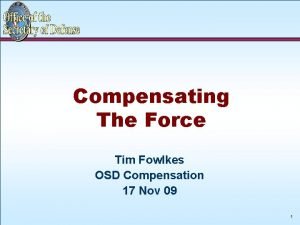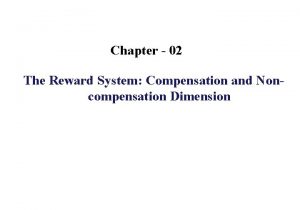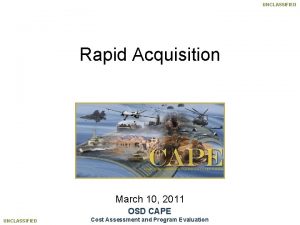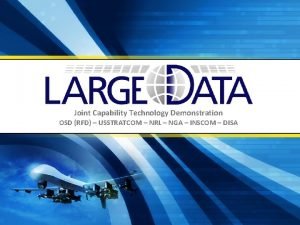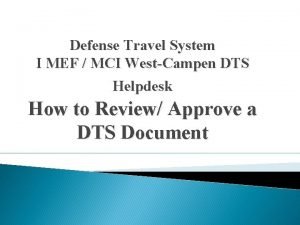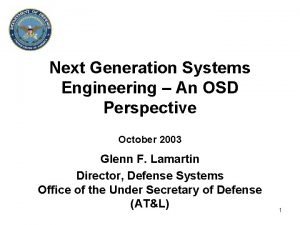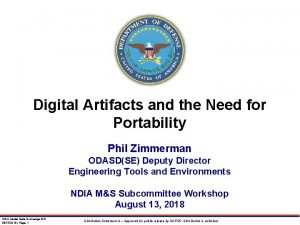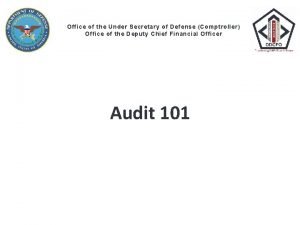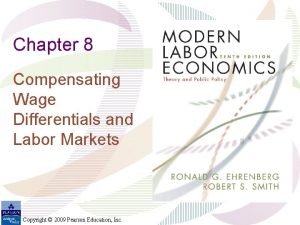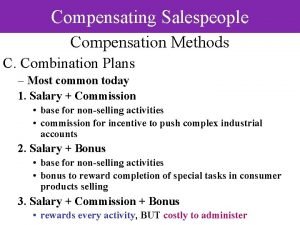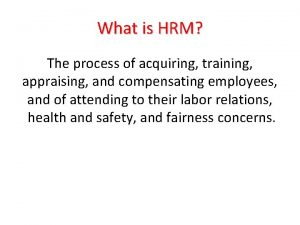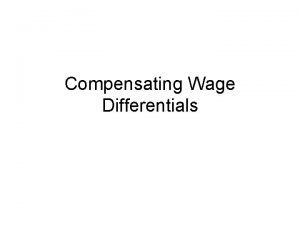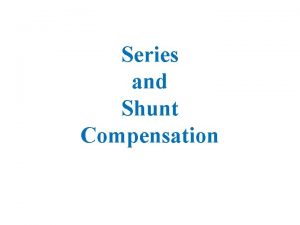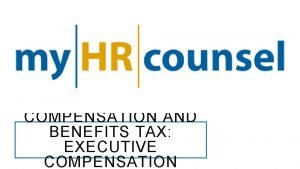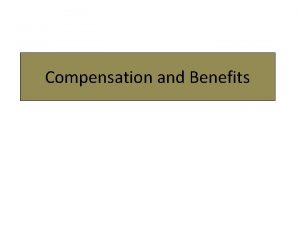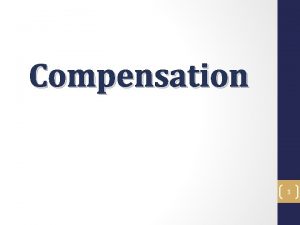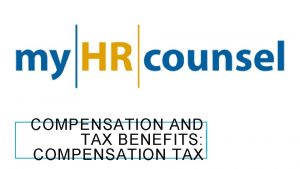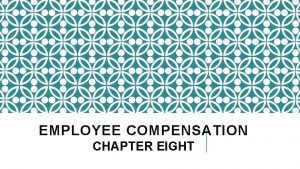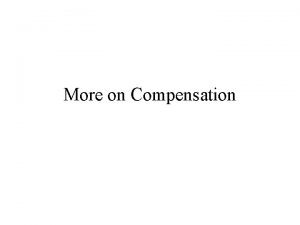Compensating The Force Tim Fowlkes OSD Compensation 17























- Slides: 23

Compensating The Force Tim Fowlkes OSD Compensation 17 Nov 09 1

Strategic Goals of Compensation Ø Recruit – Overall, critical skills, high quality Ø Retain – Overall, critical skills, high quality Ø Motivate/Reward Effective Work – Productivity & performance Ø Distribute/Align/Assign – Right people, with right skills, when and where needed (including hard-to-fill jobs) Ø Transition/Separate – Right people, right skills, right time 2

Where is Do. D’s Money… Construction Family Housing Military Personnel Research 37% Civilian Personnel Procurement Operations & Maintenance 3

Where is Do. D’s Mil. Pers Money… Special & Incentive (<5%) Housing Food Basic Pay Other Retirement Accrual (Includes Medical) 4

Away, Arduous, Danger Pay Philosophy ACTUAL COMBAT DANGER INCREASES TERRORISM HOME BASE TRAINING DEPLOYED OR TDY SERVING IN DESIGNATED IMMINENT SERVING IN DANGER HARDSHIP AREA; DUTY LOCATION HOSTILE FIRE CZTE BENEFITS SERVING IN COMBAT ZONE (CZ) OR QUALIFIED HAZARDOUS DUTY AREA (QHDA) Benefits Increase Closer to the Fight 5

Compensation of Troops: Iraq vs. CONUS Ø E-6/0 -3, married with children, serving in combat zone, with member’s counterpart serving in CONUS (while Iraq shown here, same numbers apply for members assigned in Afghanistan): 6

Compensation Regular Military Compensation (RMC) Federal Income Tax Advantage Basic Allowance For Housing Aviation Pays Basic Pay Education Benefits Medical Benefits Enlistment/Retention Bonuses Retired Pay Hazardous Duty Pays Survivor’s Benefits Death MWR Benefits Thrift Savings Plan Commissary & Exchange Other Benefits Other Allowances Submarine/Naval Pays Basic Allowance For Subsistence Hardship Duty Pays Dislocation Travel & Transportation Health Professions Pays Assignment Incentive Pay Family separation Overseas Housing Allowance Other Special Pays Responsibility Pays Special & Incentive Pays & Bonuses Overseas & CONUS COLA Evacuation Temporary Lodging Clothing 7

Special & Incentive (S&I) Pays Ø The military compensation system employs upwards of 65 statutory special and incentive pays, among them, more than 30 bonuses Ø S&I pays are used to keep military compensation flexible, competitive and efficient and… – – – Ø Overcome specific manning problems by attracting and retaining individuals with critical skills Encourage retention in career fields; and assignments involving arduous, hard-to-fill or unusual conditions Incentive pays also encourage volunteers for arduous or dangerous assignments Bonuses are used to attract and retain critical skills – Enlistment, reenlistment, skill conversion, transfer to other Service – Market driven 8

Hardship Duty Pay (HDP) Ø OSD designates hardship duty for HDP – By law, up to $1500/month payable in HDP for designated hardship duty – In application: l HDP-Mission (M): sole mission designated for HDP-M is recovery of remains of US service members lost in past wars; $150/month paid l HDP-Location (L): paid to recognize members in areas where Quality of Life is substantially below that of members generally in U. S. – By policy, max paid is $150/month • In IDP areas, max HDP-L paid is $100 (personal security issues covered by IDP) • Currently, locations in about 160 countries designated for HDP-L l HDP-Tempo (T): Inordinate personal tempo could be designated as “hardship duty” for HDP purposes as an alternative to paying “High Deployment Allowance” under 37 USC 436 9

Imminent Danger Pay (IDP) Ø Paid in designated imminent danger areas; statute requires determination that members are subject to “threat of physical harm or imminent danger on basis of civil war, civil insurrection, terrorism or wartime conditions” Ø $225 paid for any month (or portion of a month) in which duty performed in designated area Ø Currently, locations in over 45 countries and 7 sea areas are designated for IDP 10

Assignment Incentive Pay (AIP) Ø Origin: market based tool to incentivize members to volunteer for hard-to-fill assignments and less desirable locations Ø Intended to mitigate negative retention consequence of involuntary or “slam” assignments Ø With OSD approval, Service Secretaries may designate assignments and authorize a monthly AIP amount to serve in the designated assignments Ø Statutory maximum payable monthly: $3, 000 11

Family Separation Allowance (FSA) Ø Purpose is to partially reimburse members who have dependents, for added expenses when separated from their dependents Ø Paid to members who have dependents, and who as a result of military orders are separated from those dependents for over 30 continuous days Ø Amount payable: $250 monthly 12

Compensating Wounded Warriors Ø Ø Ø Traumatic – Servicemembers Group Life Insurance (TSGLI) Pay and Allowance Continuation (PAC) Prohibition of payment for meals in a military hospital by members undergoing medical recuperation or therapy Travel for families of hospitalized members Expansion of authority to remit or cancel indebtedness of members of the Armed Forces incurred on Active Duty Several compensation measures serve to assist wounded members through their recovery, rehabilitation, and/or transition to veteran status. 13

Primary Post-Service Pay and Benefits Ø Ø Separation Pays – Disability Severance – For disabilities rated less than 30%. 2 months pay per year served, with a minimum of 6 years for combat disability and minimum of 3 years for all others – Involuntary Separation (non-disability severance) – 10% of annual pay per year served Retired Pays – Disability retirement if unfit for duty – For disabilities rated 30% or greater: Pay at disability % or 2. 5% x years served – Length of Service Retirement: Must have at least 20 years of active service. Pay at 2. 5% x Years Served x Pay Base (Final or (post 1980 entry) High-36 month average) – Reserve Retirement: Must have at least 20 years of combined active and reserve service. Pay at age 60 similar to Length of Service Retirement using constructed years of active service 14

Thrift Savings Program Ø Contribution Limits: $16, 500 annually – – Ø 2011 – Roth TSP Option – – Ø $5, 500 Age 50 $49, 000 annually (Combat Zone) 2 years to implement Contribution limits will remain Web Site Renovation – – Nov 09 – Beta Version Mar 10 – Full Rollout 15

Savings Deposit Program Ø Ø Ø Members deployed to designated areas overseas can deposit up to $10, 000 Withdrawals for emergencies only Account balances are usually paid out within 90 days after the member leaves the eligible region. Deposits do not receive preferential tax treatment; interest is taxable when the member receives his/her account balance. Interest Rate: 10 percent 16

FSSA vs. SNAP Ø Do. D – Ø Family Subsistence Supplemental Allowance (FSSA) USDA – Supplemental Nutrition Assistance Program (SNAP) 17

FSSA - Background Ø Ø Started 1 May 2001 Supplemental food allowance to raise the income of eligible members to eliminate eligibility for food stamps – – Ø Ø Ø Members on active duty Entitled to BAS With dependents Income eligibility Eligibility is based on USDA criteria for food stamp eligibility, except income for FSSA purposes will include the value of government quarters Voluntary program FSSA monthly entitlement can not exceed $1100 18

FSSA - Issues Ø Ø Ø Members may qualify for SNAP or FSSA Use of food stamps by members is undesirable Do. D cannot track members receiving food stamps SNAP does not count government housing as income; FSSA does SNAP – Debit/Credit Card; FSSA - Cash 19

FSSA – Recent Fixes Ø Ø Ø Member denied FSSA, applies for SNAP, brings back SNAP qualification to receive same amount of FSSA BAH added to the LES for members living in government housing Increase visibility of FSSA Program 20

FSSA Way Ahead Ø Ø Make FSSA criteria identical to SNAP criteria? 2010 NDAA: Increase in maximum monthly amount of FSSA from $500 to $1100 21

Military Compensation (In Context) Ø Housing – – Ø Retirement – – Ø E-7 who retires at 20 gets $1. 8 million over a lifetime Lump-sum equivalent at age 38 would be $505, 000 Health Insurance – – Ø Zero out-of-pocket for average member Tailored to (variable) home size @ full local price for housing / utilities Civilian pays about $2, 700 a year 97% have additional co-pays / co-insurance averaging $1, 200 annually Non-Pay Benefits – – Commissary shopping saves 30% for typical grocery purchases Child Care -- only 14% of private industry offers child care support Source: 10 th QRMC 22

23
 Tim fowlkes
Tim fowlkes Compensation and non compensation dimensions
Compensation and non compensation dimensions Spinalni disrafizam
Spinalni disrafizam Digifort ip surveillance
Digifort ip surveillance Osd
Osd Osd cape
Osd cape Jctd
Jctd Defense travel system
Defense travel system Osd systems engineering
Osd systems engineering Osd bssn
Osd bssn Osd digital engineering strategy
Osd digital engineering strategy Osd comptroller
Osd comptroller Open billing meaning
Open billing meaning Hedonic wage model
Hedonic wage model Anteroposterior compensating curve
Anteroposterior compensating curve Compensating wage differentials
Compensating wage differentials Balanced occlusion vs balanced articulation
Balanced occlusion vs balanced articulation Konsep compensating differential
Konsep compensating differential Compensating motive
Compensating motive Who is responsible for compensating on-call employees?
Who is responsible for compensating on-call employees? Combination plan for salesperson
Combination plan for salesperson Balanced extraction
Balanced extraction Process of acquiring training appraising and compensating
Process of acquiring training appraising and compensating Lingualized occlusion advantages
Lingualized occlusion advantages
